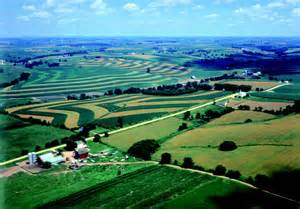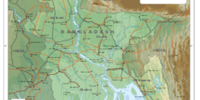Land use
USA
The United States’ land area totals nearly 2.3 billion acres. Land used for all agricultural purposes accounted for 1.17 billion acres (52% of total U.S. land) while total grazing area (grassland pasture and range, cropland pasture, and grazed forests) comprised 35% of the total and two-thirds of all agricultural land. Major land uses in 2009 were forest-use land, 651 million acres (28.8% of the total); grassland pasture and range, 587 million acres (25.9%); cropland, 442 million acres (19.5%); special uses, 297 million acres (13.1%); miscellaneous other uses, 228 million acres (10.1%); and urban land, 60 million acres (2.6%). Within the nonurban land-use categories, about 94 million acres (4.2% of total U.S. land) were estimated to be rural residential area (USDA, 2008).
UK
The UK has approximately 60 million acres of land where agriculture currently uses about 39.4 million acres of land around 66% of the total land area. The forest land contains 13% and urban land consists with 8.9% of the total land area.
China
China has approximately 2.3 billion acres of land where only 345 million acres (15%) of the land in China is good for agriculture. China feeds 22% of the world population with only 10% of the planet’s arable land. Land is heavily utilized for agriculture. There are 425 million agricultural workers in China. There are 31.6% forest land and 27% urban land in China.
India
India has approximately 734 million acres of land where 404 million acres used for agricultural purpose. There are 21% forest land and 16% urban land in India.
Bangladesh
In Bangladesh, there are total 36 million acres of land where 23 million acres of land (65%) are used for the agricultural purpose. There are 17% land area covered as forest land and about 8% land used as for the urban area.
Comparison among the Study Countries
The land use scenarios of the studying countries are not same. USA, UK, India and Bangladesh have more than 50% arable land. But China has only 15% of arable land. Again, USA and China has about one-third of total land as forest land. But UK has 13%, India has 21% and Bangladesh has only 17% of forest land. In the case of urban land, USA has only 3% of urban land, UK has about 9%, China has 27%, India has 16% and Bangladesh has about 8% of land as urban land.
Table : Land use Scenario of the Study Countries
| Country | Total Land Area (sq. km.) | Arable Land (%) | Forest Land (%) | Urban Land (%) | Miscellaneous (%) |
| USA* | 9,161,923 | 52 | 28.8 | 3 | 16.2 |
| UK | 241,590 | 66 | 13 | 8.9 | 12.1 |
| China | 9,326,410 | 15 | 31.6 | 27 | 26.4 |
| India | 2,973,190 | 55 | 21 | 16 | 8 |
| Bangladesh** | 147,570 | 64.9 | 17.08 | 8 | 10.02 |
Source: CIA World Factbook, 2008,
* USDA, 2008. **Bangladesh Forest Department, 2010. (http://www.bforest.gov.bd/land.php)
Population
USA
At present USA have 311 million populations where 82% people live in the urban area with only 3% of the urban land. The Population growth rate is 0.7% and population density is 32 people per sq. kilometer.
UK
There are about 62.4 million people live in UK where 89% people live in the urban area with 9% of the urban land. There are 255 people live per sq. km. Population growth rate of UK is 0.86%.
China
China is the most populated country of the world with about 1.33 billion population. China feeds 22% of the world population with only 10% of the planet’s arable land. There are about 50% people live in the urban area. The population density is 140 per sq. km. The population growth rate is only 0.51% in China.
India
India is the second largest populated country of the world with 1.21 billion populations. It has about 17% of world population with only 2% of worlds’ land. There are 29% people live in the urban area. The population growth rate is 1.34% and population density is 368 people per sq. km.
Bangladesh
Bangladesh is the 7th largest populated country of the world with 142 million people with only in 1,47,570 sq. km. of land. It is one of the most densely populated countries of the world. Population growth rate is about 1.38%. The Population density is 964 people per sq. km.
Comparison among the Study Countries
All of the studying countries except UK are mostly populated country of the world. China is the most populated country of the world with about 1.33 billion population. India is the 2nd largest populated country with about 1.21 billion population. USA is the 3rd largest populated country with 311 million populations. The population of Bangladesh is about 142 million and it is the 7th largest populated country of the present world. But UK has only 62.4 million populations.
Table : Population Status of the Study Countries
| Country | Total Population | *Urban Popn (%) | *Rural Popn (%) | **Popn Growth Rate (%) | Popn Density (per sq.) |
| USA | 311,807,147 | 82 | 18 | 0.7 | 32 |
| UK | 62,435,709 | 89.45 | 10.55 | 0.86 | 255 |
| China | 1,339,724,852 | 49.75 | 50.25 | 0.51 | 140 |
| India | 1,210,193,422 | 28.9 | 71.1 | 1.34 | 368 |
| Bangladesh | 142,319,000 | 27 | 73 | 1.38 | 964 |
| World | 6,932,140,100 | 48 | 52 | 1.16 | 51 |
Source: Source: USA (Official United States Population Clock, 2011), UK (Eurostat Estimate, 2011), China (Population Census, 2010), India (Provisional Indian Census, 2011), Bangladesh (Population Census, 2011)
* CIA World Factbook, 2008; ** World Bank, 2009.
It is found that most of the developed countries have higher urban population. But in the under developed or developing countries has lower urban population. From the data, it is found that UK and USA has about 82% and 90% urban population respectively. China has about 50% urban population. But India and Bangladesh has only 29% and 27% urban population respectively. Population growth rate is much higher in India and Bangladesh with 1.34% and 1.38% respectively. But rate is lower in China, USA and UK with only 0.51%, 0.70% and 0.86% respectively. Bangladesh is one of the most densely populated countries of the world with 964 people per sq. km. But USA has only 32 people per sq. km. UK, China and India has 255, 140 and 368 people per sq. km. respectively.
Economy
USA
The economy of the United States has the world’s largest national economy. Its nominal GDP was estimated to be nearly $14.7 trillion in 2010, approximately a quarter of nominal global GDP. Its GDP at purchasing power parity was also the largest in the world, approximately a fifth of global GDP at purchasing power parity. The U.S. economy also maintains a very high level of output per capita. In 2010, it was estimated to have a per capita GDP (PPP) of $47,084. US contain 32.6% of global wealth with 4.5% population according to global perspective. There are 12% populations of USA living below the national poverty line. USA ranked 4th According to UNDP’s Human Development Index (HDI) Report, 2010.
UK
The economy of the UK is the 6th largest national economy in the world measured by nominal GDP and seventh-largest measured by purchasing power parity (PPP) and the 3rd largest in Europe measured by nominal GDP (after Germany and France) and second-largest measured by PPP (after Germany). The UK’s GDP per capita is the 20th highest in the world in nominal terms and the 17th highest measured by PPP. The UK economy comprises (in descending order of size) the economies of England, Scotland, Wales and Northern Ireland. It was estimated to have a per capita GDP (PPP) of $35,843. UK contains 5.9% of global wealth with 0.9% population according to global perspective. There are 14% populations of UK living below the national poverty line.UK was 26th ranked country according to UNDP’s Human Development Index (HDI) Report, 2010.
China
China is the world’s 2nd largest economy after the United States. It is the world’s fastest-growing major economy, with average growth rates of 10% for the past 30 years. China is also the largest exporter and second largest importer of goods in the world. China became the world’s top manufacturer in 2011, surpassing the United States. The country’s per capita GDP (PPP) is $7,536 (IMF, 93rd in the world) in 2010. The provinces in the coastal regions of China tend to be more industrialized, while regions in the hinterland are less developed. China is ranked 91st ranked country according the HDI Report, 2010. There are 2.6% populations of China living below the national poverty line.
India
The Economy of India is the 10th largest in the world by nominal GDP and the fourth largest by purchasing power parity (PPP). The country’s per capita GDP (PPP) is $3,586 (IMF, 129th) in 2010.Following strong economic reforms from the post-independence socialist economy, the country’s economic growth progressed at a rapid pace, as free market principles were initiated in 1991 for international competition and foreign investment. Despite fast economic growth India continues to face massive income inequalities, high unemployment and malnutrition. India owned only 0.9% of global wealth with 17.45% of world’s population. It was ranked 122th country according the HDI Report, 2010. There are 25% populations of India living below the national poverty line.
Bangladesh
The economy of Bangladesh is a rapidly developing market-based economy. Its per capita income in 2010 was est. US $1,700 (adjusted by purchasing power parity). According to the IMF, Bangladesh ranked as the 47th largest economy in the world in 2010 in PPP terms and 57th largest in nominal terms. The economy has grown at the rate of 6-7% p.a. over the past few years. More than half of the GDP belongs to the service sector; a major number of nearly half of Bangladeshis are employed in the agriculture sector, with RMG, textiles, leather, jute, fish, vegetables, leather and leather goods, ceramics, fruits as other important produce. Bangladesh contains only 0.1% of global wealth with about 2.05% of world’s population. It was ranked 132th country according the HDI Report, 2010. There are 36.3% populations of Bangladesh living below the national poverty line.
Comparison among the Study Countries
There is some developing and developed countries are taken for this study. USA and UK are the giant economic country of the world. Per capita GDP in PPP is 47,084 $ in USA, 35,843 $ in UK. But China, India and Bangladesh has only 7,536 $, 3,586 $ and 1,486 $ GDP respectively.
Table: Economic Status of the Study Countries
| Country | Population | Per Capita GDP in PPP($) | *Owned Global Wealth (%) | HDI Rank | **Population in Poverty (%) |
| USA | 311,807,147 | 47,084 | 32.6 | 4 | 12 |
| UK | 62,435,709 | 35,843 | 5.9 | 26 | 14 |
| China | 1,339,724,852 | 7,536 | 2.6 | 91 | 2.8 |
| India | 1,210,193,422 | 3,586 | 0.9 | 122 | 28.6 |
| Bangladesh | 142,319,000 | 1,486 | 0.1 | 132 | 49.8 |
Source: World Bank, 2010, Human Development Report, UNDP (2011)
* The World Distribution of Household Wealth, UNU (2010); ** The World Factbook, CIA, 2011.
According to a report of UNU (2010), USA has owned 32.6% of the total global wealth with only 4.5% of world population. On the other hand, Bangladesh has only 0.1% of global wealth with 2.05% of world population. There is about 49.8% population living below the poverty line in Bangladesh. But population below the poverty line in USA, UK and India is 12%, 14% and 28.6% respectively but in China is only 2.8%.
Land Ownership
USA
Over 60% (1,378 million acres) of U.S. land is privately owned. The Federal Government owns nearly 28% (635 million acres), over a third of which is in Alaska. State and local governments own about 9% (195 million acres). Over 2% (56 million acres) is in trust by the Bureau of Indian Affairs. There were no major changes in these aggregate ownership patterns from 1997 to 2002.
UK
The UK has approximately 60 million acres of land in total and 70% (approximately) of this land is owned by 1% of the population. Until recently this land mass was owned by only 6,000 or so landowners, including large institutions and the Crown. However, there has been a recent shift in ownership of land as it becomes a more attractive asset to people other than traditional land owners.
China
In China, land ownership means that the land owner has the right to possess, use, benefit from and dispose of land. Land in China is not privately owned but leased from the state, typically on very long terms that allow substantial opportunity for private speculative gain. Land ownership is divided into two categories: state-owned land or state land collectively owned land or collective land. In China, urban land is owned by the state, and rural and suburban land, which is stipulated otherwise by law to be state land, is owned by the state too. Collective land is owned by the rural collective economic organization (CEO), which is roughly tantamount to the entire rural land and most of suburban land. Since 1998 China is in the midst of drafting the new Property Law which is the first piece of national legislation that will define the land ownership structure in China for years to come. The Property Law forms the basis for China’s future land policy of establishing a system of freehold, rather than of private ownership.
India
Landholding distribution too has become skewed. According to government data compiled from sources such as the All India Report on Agriculture Census 1991-2000, in 1995-96: 1.2% of landholdings in the country accounted for 14.8% of the total operational holdings with large holdings of 10 hectares and above (average holding: 17.21 hectares). 6.1% of holdings accounted for 25.3% of the total operational holdings with medium holdings of 4 to 10 hectares (average holding: 5.8 hectares). 12.3% of holdings accounted for 23.8% of the total operational holdings with semi-medium holdings of 2 to 4 hectares (average holding: 2.73 hectares). 18.7% of holdings accounted for 19.8% of the total operational holdings with holdings of 1 to 2 hectares (average holding: 1.42 hectares). As many as 61.2% of holdings accounted for only 17.2% of the total operational holdings. On average, the size of these marginal holdings was 0.4 hectares.
Bangladesh
The total farm area comprises about 62% of the total geographical area, forest area accounts for 15%, Perennial water 11% and urban area only 01%.The physical landscape is characterized by small arable fields. There are over 11 million farm holdings with more than 65 million fragments. The pattern of land ownership is highly skewed. 5% for the families having land above 7.2 acres own 26% of the land and 70% of the families having land below 2.5 acres own only 29% of the land. The per capita availability of crop land is at present only 0.24 acre.
According to BRAC Report-2008, 45% of the landless & poor marginalized peasants in the rural areas own only 5% of the total cultivable land of Bangladesh and receives 10% needed credit from institutional sources. They further said that 22% of the rich & middle farmers of rural areas of Bangladesh own 71% of the total land & receive 31% institutional credit.
Comparison among the Study Countries
The land ownership patterns among the study countries are not similar. USA and UK are economically developed countries but China, India and Bangladesh are developing countries. The landownership pattern of the developed countries is diverse than that of the developing countries.
Table : Land Ownership Status of the Study Countries in 2007
| Country | Govt. Ownership (%) | Private Ownership (%) | Others (%) | Landless People (%) |
| USA | 37 | 60 | 3 | – |
| UK | 19 | 76 | 5 | – |
| China | 70 | – | 30 | – |
| India | 28 | 56 | 16 | 40 |
| Bangladesh | 26 | 52 | 22 | 51.3 |
Source: CIA World Factbook, 2008
Private ownership of land is optimistic in the developed countries like USA and UK. It is also high in the developing countries like India and Bangladesh. But China is a developing country as well as a communist country. In China, land ownership means that the land owner has the right to possess, use, benefit from and dispose of land. Land ownership is divided into two categories: state-owned land (or state land) and collectively owned land (or collective land). In China, urban land is owned by the state, and rural and suburban land, which is stipulated otherwise by law to be state land, is owned by the state too. Collective land is owned by the rural collective economic organization, which is roughly tantamount to the entire rural land and most of suburban land.
Land Management
USA
The Bureau of Land Management (BLM) is an agency within the United States Department of the Interior which administers America’s public lands, totaling approximately 253 million acres (1,023,855 km2), or one-eighth of the landmass of the country. The BLM also manages 700 million acres (2,832,800 km2) of subsurface mineral estate underlying federal, state and private lands. The BLM is a significant revenue producer to the United States budget. In 2009, public lands were expected to generate an estimated $6.2 billion in revenues, mostly from energy development. Nearly 43.5 percent of these receipts are provided directly to states and counties to support roads, schools, and other community needs.The BLM has a wide range of responsibilities, including collecting geographic information, maintaining records of land ownership and mineral rights, conserving wilderness areas while allocating other areas for grazing and agriculture, and protecting cultural heritage sites on public land (Wikipedia, 2011).
UK
The Commissioners of Woods, Forests and Land Revenues were officials under the United Kingdom Crown, charged with the management of Crown lands. Their offices were customarily known as the Office of Woods. Under the Act of Parliament 14 and 15 Vict Cap 42 they took over from the Commissioners of Woods, Forests, Land Revenues, Works, and Buildings those functions which related to the revenue-earning parts of the Crown lands. In 1924 the Royal Forests including the New Forest and Forest of Dean were transferred from the Office of Woods to the new Forestry Commission, and the title of the Commissioners of Woods, Forests and Land Revenues was changed to Commissioners of Crown Lands. The Commissioners of Crown Lands were charged with the management of United Kingdom lands. From 1924 to 1954 they discharged the functions previously carried out by the Commissioners of Woods, Forests and Land Revenues. There were three Commissioners at any one time: the Minister of Agriculture, the Secretary of State for Scotland and one Permanent Commissioner. A cause célèbre in the 1950s caused the management of Crown lands to be scrutinized. Land at Crichel Down in Dorset requisitioned for military purposes was transferred to the Commissioners of Crown Lands when it was no longer required by the army. The previous owners wanted their land back, but the Minister of Agriculture, Thomas Dugdale, was adamant that it should not be returned. A series of reports led to the reconstitution of the management of Crown lands under the Crown Estate Acts of 1956 and 1961, removing the involvement of politicians in their management (Wikipedia, 2011).
China
Ministry of Land and Resources of the People’s Republic of China is a ministry under the jurisdiction of the State Council of China. It is responsible for the regulation, management, preservation and exploitation of natural resources, such as land, mines and oceans. On March 10, 1998, the 9th National People’s Congress passed the ‘Reform Plan of the Ministries of the State Council’. According to the plan, The Ministry of Geology and Mining, State Administration of National Land, State Administration of National Oceans, and State Bureau of Surveying and Mapping merged to form the Ministry of Land and Resources. The State Administration of National Oceans and the State Bureau of Surveying and Mapping have remained exist as departments under the jurisdiction of the newly formed Ministry (Wikipedia, 2011).
India
The Ministry of Rural Development, Government of India, has recently created a Department of Land Resources to act as a nodal department in the field of watershed management and development. This has the mandate of developing the valuable land resources of India, which are presently under various stages of degradation and it also endeavors to prevent further degradation of these resources through appropriate management and necessary measures. The Department of Land Resources, being the nodal department has taken up certain new initiatives to play a more pro-active role in the Land Resource management in the country. At the conceptual level it has been realized that the management rather than the mere use of land is the central theme. There is no dearth of land; the real issue is management which should include: dynamic conservation, sustainable development and equitable access to the benefits of intervention.
Land is the single most important ingredient for any development in the world. Unfortunately in India, land management system is in the state of gross mismanagement. Country’s extensive agricultural as well as non-agricultural land management system has collapsed. In India, we have 264 million hectares of land fit for vegetation, but of this 142 million hectares of land is cultivated and managed by private land owners. The balance 122 million hectares is uncultivated public lands, comprising 67 million hectares under the forest department and 55 million hectares under various other public authorities, which include state revenue department, panchayats and other local bodies. But the pathetic state of affairs in land management and utter confusion due to the outdated laws and regulations are doing maximum harm to our national wealth. Even after centuries, the laws governing the various aspects of land holding and use have not changed or modified to cope up with present day needs (Sapovadia, 2007).
Bangladesh
Since 1950, Ministry of Land (MoL) in different names during different regimes is entrusted with the land management of Bangladesh. The important aims and objectives of Ministry of Land are management and settlement of the Government owned lands (khas lands, jalmahal, etc.), vested properties and abandoned properties. Collection of land development tax is another important task of this ministry as well as land survey and record keeping and updating. Acquisition and requisition of land are also important responsibilities of this ministry. Thus this ministry is in charge of land administration, management and development for the benefit of the people of Bangladesh (Islam, 2000). Shafi (2007) denotes that central government ministries exercise the functions of urban land management. First and foremost is the Ministry of Lands, which exercises management functions over all land in the country, whether in rural or urban areas. Within the Ministry of Lands, land management functions are carried out at field level through the Commissioner at the division level, the Deputy Commissioner at the district level, the Assistant Commissioner (Land) at the Thana level and the Tahsildar at the Union level. The Ministry consists of three attached departments with the following responsibilities:
The Land Appeal Board was established to deal with the large volume of appeals against the decisions of the Divisional Commissioners/Additional Commissioners on land matters. It is the highest revenue court in the country, serving as the final arbiter in matters of khas land, changes in records, plot demarcation and taxation which cannot be resolved at lower levels. As such, it represents the final link in a chain running upwards from the Assistant Commissioner (Land) and Nirbahi Officer at the Upazila, through the Additional Deputy Collector (Revenue) and Deputy Revenue Collector at the district.
The Lands Reforms Board was set up to supervise the functioning of the field offices and the implementation of land management and reform efforts. The Board also provides advice and recommendations to the Government on laws, orders and rules applicable to land when and asked to do so. The Board also has a number of functions that it discharges through Upazila land offices and Union Tahsil offices. It administers khas (public) land, and manages abandoned and vested property. It updates maps and land records between surveys, sets and collects Land Development Tax. It is also formally responsible for the implementation of land reform legislation.
The Directorate of Land Records and Surveys undertakes periodic surveys to update records of land ownership and use. No special provision is made to survey urban areas compared to rural areas, even though the former change more rapidly. Among other agencies involved in urban land, the most prominent are the Housing and Settlement Directorate (HSD) and the Public Works Department (PWD), both of which are significant developers. The Local Government Engineering Department (LGED) undertakes development on urban land but is not involved in its acquisition or management (Shafi, 2007).
















